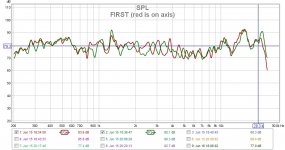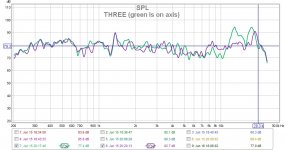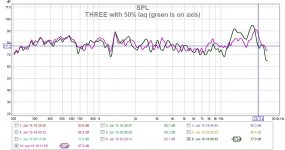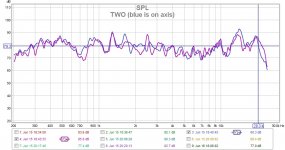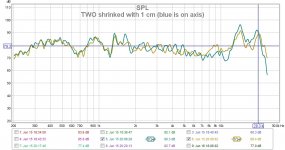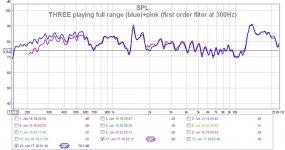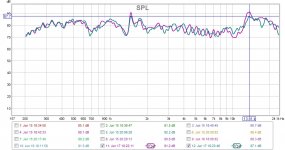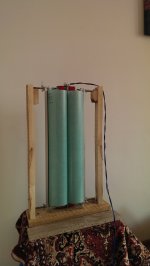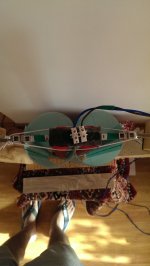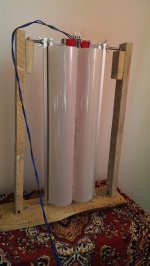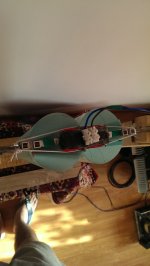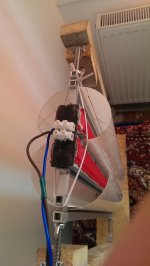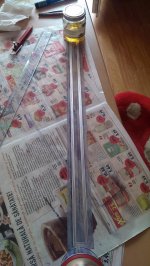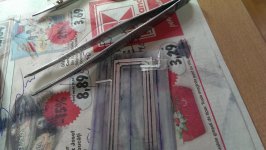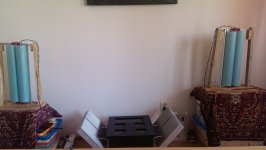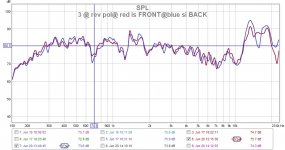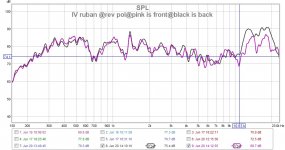Parallel yeah 6 dB louder. Since you halve the impedance. In reverse can't add dB only lower big time. If one coil wants to move forward the other wants to go back. I really can't believe that is a benefit in any way. I think you make a mistake there with the polarity. Use the hand rule
I think you didnt understand me Wrine. I didnt say it will give you more dB in reverse polarity, i sayed that it only measures better, with smoother dips and peaks. In reality i didnt hear anything, just heard here and there some details smoother, but MOST is just in measurements... I wanted to say first paralel the coil +to+ and - to - and then apply + from the amp to - of the coil and -from amp to + of the coil.
Cheers
Sergiu
Last edited:
Hi Sergiu and Wrine , i keep on reading your posts and thank you for sharing your experiences.
i just come to read the whole linaeum Patent and specially the paragraphs about the cutings in the wings and the coil thanks for speaking of that Sergiu .
So i cut 15X 8mm holes in the center of the coil and 25X6mm holes on each wing close to the coil ( 30%) I don't have any measurements but subjectively the lack of highs has disappeared and there is no more need for an extra supertweeter i would even say that it seems to be more efficient !
I will work about how to measure all this soon .
each wing is CANSON PAPER 160g/m2 47X16 CM
the coil is Double side coper printed board 10turnsX2 = 9 ohms serial /weight 17g
total weight of the 4wings +coil = 60 g
i use elastic suspension with some bracelet wire i don't know what material it is white, thin and strong ... ( silicon? )
Hello Tubegeek.
Nice. Another thing you can add on the CANSON paper is two coats laqueur on 50% of
the membrane (each cilinder) starting from the center to exterior. This will increase the hights even more and the overall dispersion wih is a good thing. Now you will really perceive a bigger sweet spot (subjectivelly). Try it, it will do no harm. With this you will really see an even bigger improvement worthwhile.
Be carefull with the exterior cuts because they can influence the voice of the singer in good (perfect voice =no more than 10 big cuts) or worse (very thin voice=bigger cuts, longer or more that 10 cuts or big and long cuts). The best for my 50 cm version was 10pcs per syde @ 2.2cm base*3.5cm hight triangles withe the cuts starting from 5 mm distance from the exterior edge of the coil. This is the optimum config that i found till now and the optimum voice.
Cheers
Sergiu
Last edited:
aha, ok parallel out of phase would be amp + to + coil 1 and to - coil 2, - amp to - coil 1 and + coil 2.
so yours actually just moves backwards instead of to the front with a positive signal. witch in the end should not make much difference i believe. since a sound is made up of positive and negative signals. 🙂
so yours actually just moves backwards instead of to the front with a positive signal. witch in the end should not make much difference i believe. since a sound is made up of positive and negative signals. 🙂
Last edited:
Yeah, you're right but very strange it really smooths abit the dips and peaks. Dont know why. I'm not trying to say or prove that the wheel is square instead of round but take a look two pages back to the "classic" version measurements. I was amazed twoo. Please try and tell me what you get.aha, ok parallel out of phase would be amp + to + coil 1 and to - coil 2, - amp to - coil 1 and + coil 2.
so yours actually just moves backwards instead of to the front with a positive signal. witch in the end should not make much difference i believe. since a sound is made up of positive and negative signals. 🙂
2 pages back is not a comparison from reversed and normal 🙁 or at least i cant find it. but if they are not measured at exact same condictions stuff changes, even slightest movement will cause weird things since the polar response of the rubanoide is not that smooth 🙂. but i guess you only changes the connections so all should be well.
one thing you should try, is maybe also reverse the whole speaker. so you have.
Normal,reverse polarity,and normal but physically reversed. i really have no clue what it could be. i thought about maybe spring in one direction, but this should only result in distortion not so much in smoothing. and would not change when reversing polarity 🙁 damned i dont know
one thing you should try, is maybe also reverse the whole speaker. so you have.
Normal,reverse polarity,and normal but physically reversed. i really have no clue what it could be. i thought about maybe spring in one direction, but this should only result in distortion not so much in smoothing. and would not change when reversing polarity 🙁 damned i dont know
Last edited:
Here it is my friend (reversed polarity):
http://www.diyaudio.com/forums/plan...on-speaker-different-kind-77.html#post4731652.
http://www.diyaudio.com/forums/plan...on-speaker-different-kind-77.html#post4731652.
2 pages back is not a comparison from reversed and normal 🙁 or at least i cant find it. but if they are not measured at exact same condictions stuff changes, even slightest movement will cause weird things since the polar response of the rubanoide is not that smooth 🙂. but i guess you only changes the connections so all should be well.
one thing you should try, is maybe also reverse the whole speaker. so you have.
Normal,reverse polarity,and normal but physically reversed. i really have no clue what it could be. i thought about maybe spring in one direction, but this should only result in distortion not so much in smoothing. and would not change when reversing polarity 🙁 damned i dont know
I will try this tomorrow.
Cheers
Sergiu
Here they are: The measurements for the membranes from here :
http://www.diyaudio.com/forums/plan...on-speaker-different-kind-80.html#post4746790
I played abit more with the blue membranes because they have paper on them and are lighter.
I will post my listening impressions later because now i'm listening to them as we speak.. 😀
http://www.diyaudio.com/forums/plan...on-speaker-different-kind-80.html#post4746790
I played abit more with the blue membranes because they have paper on them and are lighter.
I will post my listening impressions later because now i'm listening to them as we speak.. 😀
Attachments
Well, after yesterdays experience i can say that ruban 1 is too rigid becuase the double adhesive tape has a glue on it wich is like rubber when combined with laq and makes the sound is abit restrained, and the sound isnt opened any more. It measures pretty well but i can really sense that it has fewer dB..
Ruban 2, with 250gr membr with paper former is better in any aspects compared to 1, wich confirms again the aspect that the adhesive doesnt have to bee too hard or in excess. The sound has now the feeling of airy and its spacious, but its buzzing abit, wich means that using copper wire insyde the bonding area is a ni go..
Ruban 3, the blue one, with paper bonded to the folium, is faster than the others and seems to reveal more details than the others, wich i think its because of the 225gr membr wich, if you remove the paper you will have a 180 gr pure folium membr.
This 3rd edition is lacking hights and if i added 50% laq i made the voices more round and more pronounced. Strange thing. Another aspect is that this vers has more dB than the other two.
Also this folium has poorer dispersion than the other two vers.
With these foliums i made the best centering till now. The coil is very rigid and doesnt bend anymore, not even 1 mm..
My conclusions are:
*dont use membrane heavyer than 180gr for the former(folium or not);
*use a rigid folium or material only for the former and NEVER use double adhesive tape because of the adhesive on it;
*you can use folium with paper on it, but only on one syde , and let the paper syde on the insyde of the cils and the folium syde on exterior;
Cheers
Sergiu
Ruban 2, with 250gr membr with paper former is better in any aspects compared to 1, wich confirms again the aspect that the adhesive doesnt have to bee too hard or in excess. The sound has now the feeling of airy and its spacious, but its buzzing abit, wich means that using copper wire insyde the bonding area is a ni go..
Ruban 3, the blue one, with paper bonded to the folium, is faster than the others and seems to reveal more details than the others, wich i think its because of the 225gr membr wich, if you remove the paper you will have a 180 gr pure folium membr.
This 3rd edition is lacking hights and if i added 50% laq i made the voices more round and more pronounced. Strange thing. Another aspect is that this vers has more dB than the other two.
Also this folium has poorer dispersion than the other two vers.
With these foliums i made the best centering till now. The coil is very rigid and doesnt bend anymore, not even 1 mm..
My conclusions are:
*dont use membrane heavyer than 180gr for the former(folium or not);
*use a rigid folium or material only for the former and NEVER use double adhesive tape because of the adhesive on it;
*you can use folium with paper on it, but only on one syde , and let the paper syde on the insyde of the cils and the folium syde on exterior;
Cheers
Sergiu
I found something more interesting. The folium with paper ( Three) let me shrink the cilinders even more without bendings or crippling (i shrinked them at 3 cm per half@from plate to center of one cil). The measurements are astonishing at last (+-5dB in all the band when goying full range). I measured it 4 times just to be shure and all the results where the same.
Wrine, my friend, look at the measurements bellow (i aded a full range chart vs first order filter and the first order filtered ruban on axis and off axis measurements). What do you say?
As you can see now with the folium, the ruban goes down to 150hz and up to 24khz and who knows actually how high it goes because i have limited hardware on my integrated audio soundcard in the pc.
In the first order filter aded (first chart fron left to right) pink is on axis and green on axis, and on the rights chart (full range vs filtered) bothe measurements are on axis.
I will go now to listen to them.
Cheers
Sergiu
Wrine, my friend, look at the measurements bellow (i aded a full range chart vs first order filter and the first order filtered ruban on axis and off axis measurements). What do you say?
As you can see now with the folium, the ruban goes down to 150hz and up to 24khz and who knows actually how high it goes because i have limited hardware on my integrated audio soundcard in the pc.
In the first order filter aded (first chart fron left to right) pink is on axis and green on axis, and on the rights chart (full range vs filtered) bothe measurements are on axis.
I will go now to listen to them.
Cheers
Sergiu
Attachments
Last edited:
Here they are. The vers 3 (blue membr) and 2 (transparent thick white membr). The first was dissasembled because of the poor listening impressions it left.. 🙁
Attachments
Well after playing abit with the 3 version (elastics, laq, and other stuff) and listening to it with cilinders shrinked down i can say that i like this version.
I have to increase abit the hights (subjectivelly, because in measurements all its ok) BUT this problem will be solved when i will add the cuts. The mids are now perfect, this variat its a combination between sound projector (when the singer its singing is in your face) and the "feeling like your there" feeling (when you have the impression that you are sitting near the singer and/or the instruments, feeling that others call it "live concert" or sitting in the first line at the concert). The voice is there when it is recorded like it, and laid back whe its recorded like this. The voice its no more like a sound projector Wrine, like in the old variants, i can say now that the voice, details, hights, depth and dinamics are like the real deal. This variant also shows the singer when its breathing or the sound that you hear when the singers lips makes a click noise when its mouth its dry (you know what i mean😉 ) ..
I wanted to try different materials just to find a proper solution for the temporary bending of the membrane right in the middle of the membrane when excessive humidity was in the house and found it. It seems that in the end this is the best sollution.
The usage of folium seems a good solution but only a thick folium because a thinner folium used without dampening (fabric paper aded on it or other solutions) will resonate easyer than paper in the mids frecv.
When using paper the adenum of 2 to 3 coats of laq on the insyde of the cilinder (in the coil area +3cm near it) is a MUST because at high humidity ambiance like i have it bends in a 3mm gap. The aded mass can easily be compensated with the cuts and 50% laq on the exterior.
For me going back to 4 mm gap its not a solution because i want higher dB.
The folium is a elegant solution in wich you dont have to scratch your head with how much coats of laq you have to add, where to add, or when its dry or how to compensate the adenum of mass...
I will test some more things tomorrow like the position of elastics and report back.
Another aspect is that i made another former, this time its made from 250gr/smq folium with hard laq on it (will not use double adhesive tape never) and more atention to details like the connection with copper wires as you can see in the pics bellow (they are now extended outsyde with Al foil). I will use this former with the blue membranes that i cuted.
Another aspect that i have to test again is the inversed polarity...
Anyway, will see tomorrow how it will go.
Cheers
Sergiu
I have to increase abit the hights (subjectivelly, because in measurements all its ok) BUT this problem will be solved when i will add the cuts. The mids are now perfect, this variat its a combination between sound projector (when the singer its singing is in your face) and the "feeling like your there" feeling (when you have the impression that you are sitting near the singer and/or the instruments, feeling that others call it "live concert" or sitting in the first line at the concert). The voice is there when it is recorded like it, and laid back whe its recorded like this. The voice its no more like a sound projector Wrine, like in the old variants, i can say now that the voice, details, hights, depth and dinamics are like the real deal. This variant also shows the singer when its breathing or the sound that you hear when the singers lips makes a click noise when its mouth its dry (you know what i mean😉 ) ..
I wanted to try different materials just to find a proper solution for the temporary bending of the membrane right in the middle of the membrane when excessive humidity was in the house and found it. It seems that in the end this is the best sollution.
The usage of folium seems a good solution but only a thick folium because a thinner folium used without dampening (fabric paper aded on it or other solutions) will resonate easyer than paper in the mids frecv.
When using paper the adenum of 2 to 3 coats of laq on the insyde of the cilinder (in the coil area +3cm near it) is a MUST because at high humidity ambiance like i have it bends in a 3mm gap. The aded mass can easily be compensated with the cuts and 50% laq on the exterior.
For me going back to 4 mm gap its not a solution because i want higher dB.
The folium is a elegant solution in wich you dont have to scratch your head with how much coats of laq you have to add, where to add, or when its dry or how to compensate the adenum of mass...
I will test some more things tomorrow like the position of elastics and report back.
Another aspect is that i made another former, this time its made from 250gr/smq folium with hard laq on it (will not use double adhesive tape never) and more atention to details like the connection with copper wires as you can see in the pics bellow (they are now extended outsyde with Al foil). I will use this former with the blue membranes that i cuted.
Another aspect that i have to test again is the inversed polarity...
Anyway, will see tomorrow how it will go.
Cheers
Sergiu
Attachments
loads of good news !!! 🙂 , what is folium ? some sort of foil i presume but how much grams and what material ?
im pretty busy with work 🙁 so not much news coming from me 🙁
im pretty busy with work 🙁 so not much news coming from me 🙁
loads of good news !!! 🙂 , what is folium ? some sort of foil i presume but how much grams and what material ?
im pretty busy with work 🙁 so not much news coming from me 🙁
No probs my friend. I just assembled the 4 variant (the one with folium variant@former without glue on it like the double ashesive tape case). Now we are comparing apples with apples as seen in the pics bellow except the former density and material.
The folium that i use for the 4 variant is the same as the one used on the very heavy ruban membranes (with poor dB) @250gr/sqm, and guess what, it seems that the density of the material heavily influences the mids and hights region as i listen to both of them (subjectivelly). The 4 version, is now without the 50% aded laq on the membrane and beats the c**p out of 3rd in terms of clarity and extended hight frecv. All other caracteristics remains the same.
Attachments
Wrine, here they are: the reverse pol vs corect polarity results. They are on axis measurements of the 3 version. I made the cilinders back to 4 cm hight per half. Blue is reverse pol (i wrote out of phase) . As you can see i pointed out with the program cursor the zone where it has been afected most.
As you can see the polarity does influence the measurements of this speaker. I'm keeping it out of phase (reverse polarity)...
Cheers
Sergiu
As you can see the polarity does influence the measurements of this speaker. I'm keeping it out of phase (reverse polarity)...
Cheers
Sergiu
Attachments
No probs my friend. I just assembled the 4 variant (the one with folium variant@former without glue on it like the double ashesive tape case). Now we are comparing apples with apples as seen in the pics bellow except the former density and material.
The folium that i use for the 4 variant is the same as the one used on the very heavy ruban membranes (with poor dB) @250gr/sqm, and guess what, it seems that the density of the material heavily influences the mids and hights region as i listen to both of them (subjectivelly). The 4 version, is now without the 50% aded laq on the membrane and beats the c**p out of 3rd in terms of clarity and extended hight frecv. All other caracteristics remains the same.
Still it would be very nice to know what material this "folium" was made of.
Some sort of Plastic?
Impressive findings keep comming. Here we are Wrine as you sugested: reversed polarity front measured vs back measured on 3 (III) and 4 (IV) versions. Measures are taken 4 times on each speaker at 5 mins differences (because i couldnt believe it!!!). Checked twice the bondings between the membranes, the coils, the centering. I used the same distance for measuring, and the same dB when checked dB SPL (around -22.5dB each time) so each time i have the same conditions.
The strangest conclusion till now is that the speaker polarity influences the overall frecv response on each syde front and back.... 🙁🙁😕😕😕



Look at the graphs bellow, normally it shouldnt be like this......
PLease measure too and report back.
The strangest conclusion till now is that the speaker polarity influences the overall frecv response on each syde front and back.... 🙁🙁😕😕😕




Look at the graphs bellow, normally it shouldnt be like this......
PLease measure too and report back.
Attachments
Still it would be very nice to know what material this "folium" was made of.
Some sort of Plastic?
Yes its 4Kv insulation foil/folium @250gr/sqm used for trafo winding. Its used on trafos in the specialised winding ateliers, and its sticked with laq in between each copper layer winded and its there for extra insulation.
Impressive findings keep comming. Here we are Wrine as you sugested: reversed polarity front measured vs back measured on 3 (III) and 4 (IV) versions. Measures are taken 4 times on each speaker at 5 mins differences (because i couldnt believe it!!!). Checked twice the bondings between the membranes, the coils, the centering. I used the same distance for measuring, and the same dB when checked dB SPL (around -22.5dB each time) so each time i have the same conditions.
The strangest conclusion till now is that the speaker polarity influences the overall frecv response on each syde front and back.... 🙁🙁😕😕😕


Look at the graphs bellow, normally it shouldnt be like this......
PLease measure too and report back.
Well i found the problem on IV version: it seems that the front is bonded corectly and the back , well, the back is NOT.
The conclusion is that PEOPLE BE CAREFULL AT GLUING THE FORMER TO THE CILINDERS. If its not bonded proprely you have peaks and resonances. You can easily check this with a mic, and if the back measurement differs too much from the front then you have a bonding issue.
To continue with my measurements i will use the front wich has lower resonances and has lower peaks and dips.
Look at the pic that i draw bellow and you will see what i meant. As you can see in the back, the glue has drained down leaving too much of the former exposed, but in the front, because i have seen the laq and the super glue from the back draining down i applyied the gue when the ruban was laying horizontally (its the best way to rectify the membrane if it doesnt bond from the start).. I draw it because you couldnt see it in the pic..
Attachments
Last edited:
Now i will play abit more with IV ruban, because the foil former version (IV) scored better both in measurements and listening sessions. I will not post anymore the off axis response because we all know that off axis is way better than on axis. 🙂
- Home
- Loudspeakers
- Planars & Exotics
- A DIY Ribbon Speaker of a different Kind
